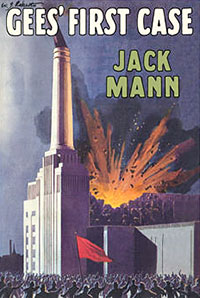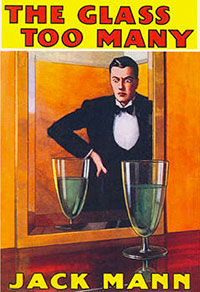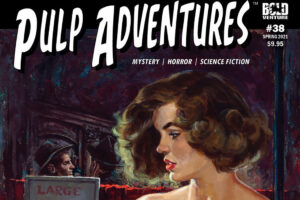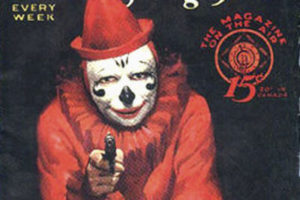 Detective Gregory George Gordon Green, or “Gees” as he prefers, was created by British author and editor Charles Henry Cannell (1882-1947), better known by one of his pseudonyms E. Charles Vivian. However, these were written under his Jack Mann pseudonym.
Detective Gregory George Gordon Green, or “Gees” as he prefers, was created by British author and editor Charles Henry Cannell (1882-1947), better known by one of his pseudonyms E. Charles Vivian. However, these were written under his Jack Mann pseudonym.
The series consists of:
- Gees’ First Case (1936)
- Grey Shapes (1937)
- Nightmare Farm (1937)
- The Kleinart Case (1938)
- Maker of Shadows (1938)
- The Ninth Life (1939)
- The Glass Too Many (1940)
- Her Ways Are Death (1941)
All eight are available from Ramble House in both paperback and hardcover. I recently got a couple of the earlier volumes and enjoyed them. As I understand, all were originally published in book form in England, then a few were reprinted in the pulps (a couple being serialized in Argosy).
We are introduced to Gees in Gees’ First Case. We learn that he is “beautifully-ugly,” and his feet and hands are unusually large. He is the son of a general, who appears in the story and is frankly disappointed in his son, whom he thinks is wasting his potential. (I’m uncertain if this is a reoccurring theme in the books, but looks like it.)
Gees was a policeman for two years and recently quite when he started his little detective agency. It’s just him and a secretary, Eve Madeleine Brandon. She is noted as being very pretty, but has ignored his advances, which is why he hired her. No hanky panky there. She seems to stay at the office, transcribing his cases (he sets up a microphone so she can hear what the clients say and takes notes) or doing research for him.
Gees investigates anything from “mumps to murder,” as his card says.
This first story is pretty straightforward, where Gees gets involved with a group of communist revolutionaries who hope to cause chaos leading to a revolution with a new elite ruling over all. Basically them. He gets involved after meeting their roving inspector, a pretty girl, on a train. She thinks he’s fallen for her charms, but he hasn’t. She, however, as fallen for him. He is able to thwart their plans, and their revolution is stopped. All are arrested, but Gees makes sure the girl leaves the country. But it has the added effect of making him well known, so this will lead to further cases (and the fact that their slush fund just happens to wind up in Gees’ position is just added gravy).
However, in the second one Gees will be facing various occult matters. In Grey Shapes, Gees must contend with werewolves. Here they are relics of the ancient Azilian race. The Azilian race is one that Cannell made up, and they (or their descendants) will appear in further works. They are an ancient pre-medieval people who worship a demon goddess called “The Unnamed.” Sadly, I haven’t read that one yet, so no idea how things turn out.
I messed up and got the third book, Nightmare Farm. Here Gees deals with the supernatural beings who once guarded the lost city of Kir-Asa, who now seem to be “haunting” a farm and have possessed a young girl. This actually makes it a sort of sequel to City of Wonder, written under the E. Charles Vivian pseudonym. It’s been out of print for awhile, so I hope Ramble House will reprint it. Here, Kir-Asa is noted as a real, though legendary or even mythical, city somewhere in the Pacific. It’s noted that someone wrote a novel based on the legends, which may be a hint at City of Wonder. We also get an interesting speculation as to the origins of these beings.
The farm is located near the estate of Gees’ family, and there are apparently some connections between the owners and his family. Gees figures out the mystery of the beings, is able to help the girl, and puts an end to it. But things don’t work out well for all concerned, tragically. This appears to be another theme in these works as well. (Since he can’t get it on with his secretary, he’ll be falling for a girl in each story I suppose.)
It’s clear from reading these two that Gees is of the type of occult detective who is an ordinary man, with ordinary skills and knowledge, who happens to find himself confronting the supernatural. That’s unlike other occult detectives who have already have skill and knowledge of the occult, and in some cases seek it out. But it does appear the Gees learns from each of his cases to help him in the future.
I look forward to reading the subsequent books.
Next up is The Kleinart Case. Don’t know much about it, other than a German has hired Gees to protect him from “nothing.”
From what I gather, in Maker of Shadows, Gees goes up against a evil wizard Gamel MacMorn, a survivor of the Azilian race. Gees is called in to help a Scottish family who has been fighting MacMorn off for generations. MacMorn has the ability to regenerate every so often, so he basically comes back as his “son.” This story was so popular it was serialized in Argosy with illustrations by Virgil Finley.
The Ninth Life is a femme-fatale story about a survivor from ancient Egypt. Don’t know much else, but know it was also serialized in Argosy. I am going to guess that Gees falls for and fails to save said femme fatale.
 Next up is The Glass Too Many, is a sort-of sequel to The Maker of Shadow, with another descendant of the Azilial race causing problems. Here, someone is trying to poison a British lord, making it an almost country manor murder mystery. With the added layer of occult mystery.
Next up is The Glass Too Many, is a sort-of sequel to The Maker of Shadow, with another descendant of the Azilial race causing problems. Here, someone is trying to poison a British lord, making it an almost country manor murder mystery. With the added layer of occult mystery.
The final work, Her Ways Are Death, has Gees failing to save another femme fatale he seems to fall for. There is apparently even some kind of assistance from Thor. From another review it appears that the mythology underlying the series is given its fullest elaboration. For that alone, I look forward to reading this one.
I plan on getting the other works and seeing how they are. I’ve liked what I’ve read so far. One thing I noted is that with Nightmare Farm that there are hints to what happened in The Gray Shapes, and it’s clear that Kleinert Case is next. No idea if this happens in the rest, so it may be a good idea to read them in order. As noted, Gees seems to learn from each case, so it will be interesting to see how that progresses. So probably a good idea to read them in order.
I recommend others check these out, as well as checking out what Ramble House has. They have a lot of reprints of works that pulp fans should enjoy. Also, contact them directly about getting better pricing than what you can obtain from Amazon. My only complain is I wish they had better descriptions of each of the books on their website and the back covers of the book.
Updated & corrected.




As a teenage nerd some fifty years ago, I read several of these in issues of “A. Merritt’s Fantasy Magazine,” “Famous Fantastic Mysteries,” and “Fantastic Novels.” I remember that I liked them pretty well at that time. I tried to get some more of the Gees novels, but they were very hard to find, and I didn’t manage to locate even one. Nice to know that they are all now available.
Ramble House got the dates of publication wrong.Grey Shapes and Nightmare Farm were published in 1938 not 1937. Her Ways Are Death was the last of the Gees Novels to be published in 1941. The 3 Novels reprinted in Argosy and A, Merritt’s Fantasy – Maker of Shadows, the Ninth Life and Her Ways are Death are all massively censored/expurgated in the old pulps. About a quarter of the running length is missing on them. And the edits are all through the novels. Everything from mild blasphemies to descriptions and English phrases. These travesties of the original books should be avoided the art work being the only noteworthy thing about them. (In fact everything published in Famous Fantastic Mysteries and Fantastic Novels was massively expurgated with the possible exception of A Merritt who retained some control of his output)
The Bookfinger and Ramble House editions are NOT expurgated.Grey Shapes Nightmare Farm, Maker of Shadows, Ninth Life and Her Ways are Death are excellent fantasy novels… the other 3 are good non-fantasy novels. Well done Ramble House for managing to source the long – inaccessible Kleinert Case. The Bookfinger editions are actual facsimilies of the Wright and Brown First Editions
thanks for the updates on the dates.
I was looking at several sources as to the dates, many of which didn’t match. I’m not sure I based the dates I gave on what Ramble House has.
So does this mean “Her Ways are Death” is the last in the series, not the 7th??
I was only aware of the first novel as being non-fantasy. I assumed the Kleinert Case and The Glass Too Many were fantasy. (haven’t read them yet).